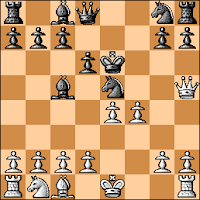Wall, Bill - Guest273475
PlayChess.com, 2017
1.e4 e5 2.Nf3 Nc6 3.Bc4 Bc5 4.Bxf7+
4...Kxf7 5.Nxe5+ Nxe5 6.Qh5+ Kf8
The Jerome Variation of the Jerome Gambit, played by Alonzo Wheeler Jerome against David Jaeger in correspondence, 1880.
7.Qxe5 d6 8.Qg3 Nf6
Also 8...h5 appeared in Wall,B - Thieveyen, Chess.com, 2010 (1-0, 61), while 8...d5 was played in billwall - bfcace, Chess.com, 2012 (1-0, 25).
9.Nc3 Be6
Instead, 9...Nh5 led to an exchange of Queens after 10.Qf3+ Qf6 11.d3 Qxf3 12.gxf3 in Wall,B - Ahmadi,S, Chess.com, 2010 (0-1, 59). A rare loss by Bill in the Jerome Gambit, so it is worth checking out.
10.O-O Kf7 11.d3 Rf8 12.Na4
It is not always smash! and crash! in the Jerome Gambit. Sometimes you just grab the "minor exchange" of Bishop for Knight.
On the other hand, there is always 12.Be3 Nh5 13.Qf3+ Kg6 14.Qe2 Nf4 as in Wall,B - Guest874250, PlayChess.com, 2014, (0-1, 32).
12...Bb6 13.Nxb6 axb6 14.a4 Kg8
Black has castled-by-hand and still has his piece for a couple of pawns. What is White to do? Advance the "Jerome pawns", of course.
15.f4 Qd7 16.f5 Bf7 17.b3 Rfe8 18.Bb2 Qe7 19.Rae1 Kh8
White has stubbed his toe in this variation before, so he prefers now to put his pawns and pieces on the right squares and see what happens. (Stockfish 8 agrees with him, rating the position, at 28 ply, as "0.00" - even.) Sometimes these "small" moves put pressure on Black to play chess, not just react to threats.
20.c4 Ra5 21.Bc3 Raa8 22.Re3 Qf8
It is interesting that the computer considers this move an error, and recommends, instead, opening the Queenside with 22...b5 23.axb5 Ra3. It then sees a way, through pawn and Queen exchanges, to an edge for Black, despite leaving White with three pawns (two of them passed) for a piece: 24.Rb1 Ra2 25.Rbe1 Nh5 26.Qg4 Rc2 27.Bd4 Nf6 28.Qd1 Ra2 29.e5 dxe5 30.Bxe5 Qd7 31.Qf3 c6 32.bxc6 Qxc6 33.Qg3 Nh5 34.Qf3 Qxf3 35.Rxf3 Nf6 36.h3 b5 37.cxb5 Bxb3 38.Rfe3. This is a subtle position, one the better player will navigate more easily.
23.Qh4
This is the move the computer recommends, and I find it highly ironic. Not too long ago, humans used to adopt "anti-computer" strategies (with White) that included locking the position up with pawns (say, with the Stonewall opening) followed by a slow advance of Kingside pawns toward the enemy monarch. It is as if Stockfish has learned this lesson and suggests that White move his Queen and unblock his g-pawn.
It is interesting that Bill pursues a different line of play - until he is helped by what one famous computer (HAL) would call "human error".
23...Nd7 24.Rh3 Qg8 25.Rg3 Ne5 26.d4 Nd7 27.e5
Black was pretty sure that he had prevented this move, as the advance costs White a pawn. However, it also leads to the opening of the deadly a1-h8 diagonal for White's Bishop. (Looking at the current position, it is easy to overlook this fact, as the diagonal looks clogged with pawns, and it will soon inherit a Knight - but the piece will be unable to stay there.) Add that to the pressure along the g-file, and that spells disaster.
27...dxe5 28.dxe5 Nxe5 29.Qf4
Aha! The Knight on e5 is attacked twice and defended once...
29...Ng6
Hoping to block the g-file and protect the vulnerable g7 square. Best was probably 29...Nc6, when 30.Bxg7+ Qxg7 31.Rxg7 Kxg7 would lead to a very interesting position where Black would have a Rook and two minor pieces of his Queen. Would that be enough?
Probably not. After 32.f6+! White could show that there are two more features to the position - White's advanced pawn, and the unsafe position of Black's King. Therefore 32...Kh8 (forced) 33.Qg3 Rg8 34.Qxc7 follows, and what is Black to do?
The line 34...Bg6 35.Qxb7 Ne5 36.Qxb6 reminds me of the arcane expression "nibbled to death by ducks"; Black will not be able to coordinate his pieces, protect his King, and deal with White's 4 passers.
Instead, Black could try 34...Nd8, although White could continue to apply pressure to the contorted positions with 35.Rd1, e.g. 35...Rf8 36.Qxb6 Kg8 37.Rd7 Bg6 38.Qc7 Nf7 39.Qxb7 (or 39.h4). Again, White's passed pawns would be decisive.
However, the text move, returning a piece, falls tactically.
30.fxg6 Bxg6 31.Rxg6
You saw this move, right?
31...hxg6 32.Rf3 Black resigned
Black can defend against the threat down the h-file with 32...Ra5, but that simply costs a Rook after 33.Bxa5, as he does not have time for 33...bxa5 because of 34.Rh3+, losing his Queen. Instead, he can take advantage of the diverted Bishop by giving his King some breathing space with 33...Qe6, but after 34.Bc3 (of course) he would be a piece down and vulnerable after 34...Qe7 35.Qf7 Qxf7 36.Rxf7 or 34...Kg8 35.Qxc7.















































